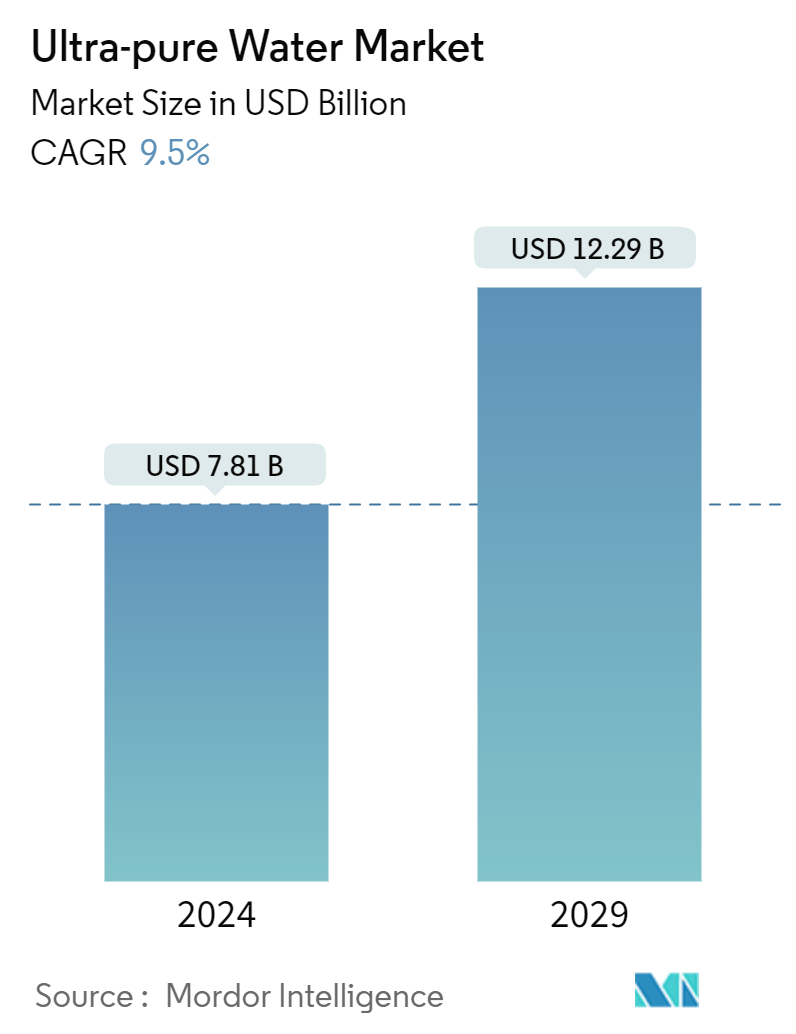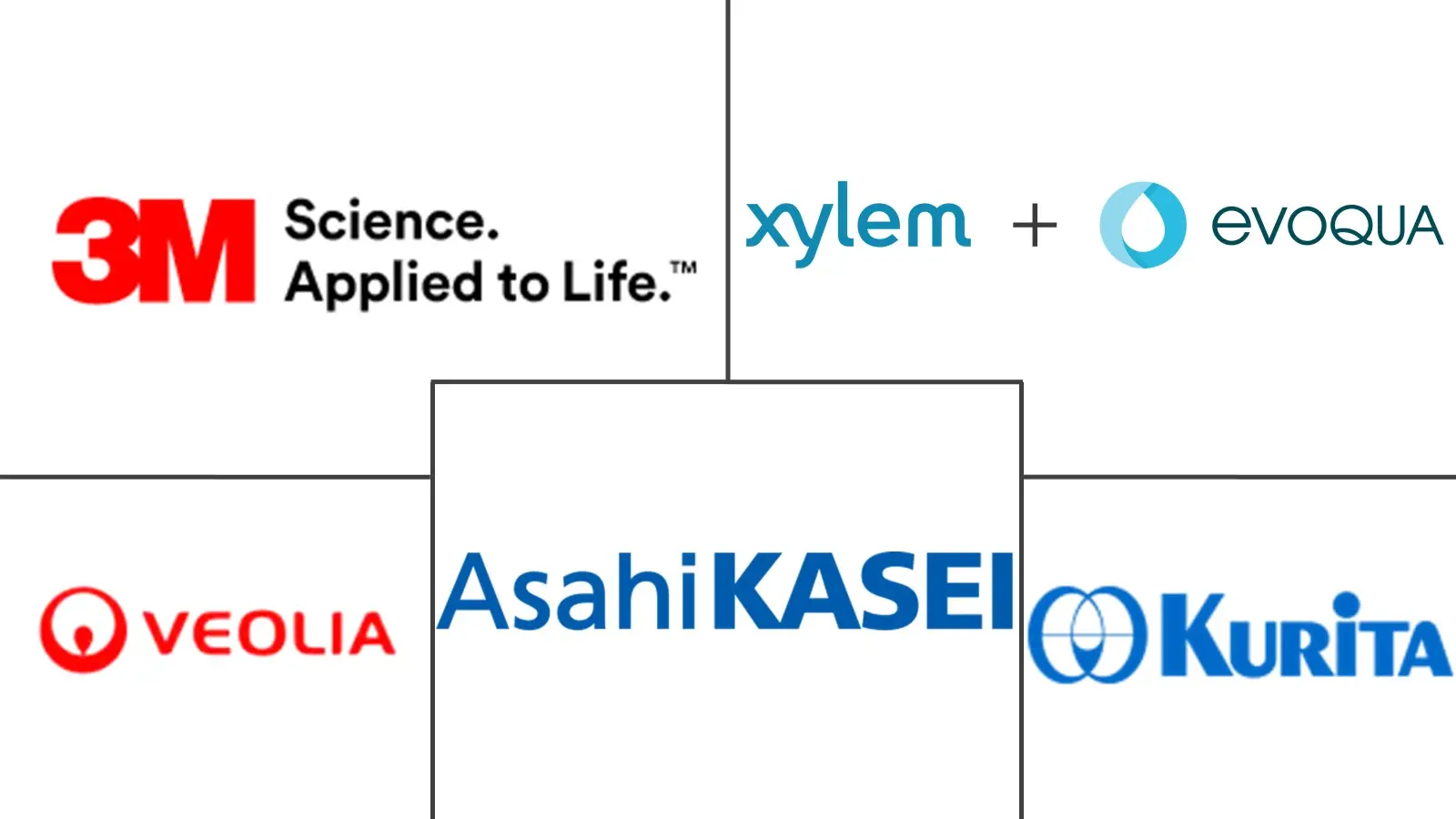Market Size of Ultra-pure Water Industry

| Study Period | 2019 - 2029 |
| Market Size (2024) | USD 7.81 Billion |
| Market Size (2029) | USD 12.29 Billion |
| CAGR (2024 - 2029) | 9.50 % |
| Fastest Growing Market | Asia Pacific |
| Largest Market | Asia-Pacific |
| Market Concentration | Low |
Major Players
*Disclaimer: Major Players sorted in no particular order |
Ultra-pure Water Market Analysis
The Ultra-pure Water Market size is estimated at USD 7.81 billion in 2024, and is expected to reach USD 12.29 billion by 2029, growing at a CAGR of 9.5% during the forecast period (2024-2029).
The demand for ultrapure water decreased in a few industries due to the COVID-19 pandemic. However, the application of ultrapure water has increased in the pharmaceutical industry. Post-pandemic, the demand for ultrapure water has increased significantly in various industries, including semiconductors, pharmaceuticals, and power generation.
- In the short term, growing demand from the semiconductor industry and the rising pharmaceutical industry are likely to drive market growth.
- The availability of limited and polluted water resources is expected to hinder the market's growth.
- Nevertheless, the requirement for ultrapure water in green hydrogen production is likely to create lucrative growth opportunities between 2024 and 2029.
- Asia-Pacific is expected to dominate the market and is likely to witness the highest CAGR from 2024 to 2029.
Ultra-pure Water Industry Segmentation
Ultra-pure water (UPW) has been purified to high standards and is used to ensure contaminants don't impact various processes. Semiconductor, pharmaceutical, and power generation are major industries that utilize ultrapure water for cleaning, etching, and other applications.
The ultrapure water market is segmented by application, end-user industry, and geography. By application, the market is segmented into cleaning, etching, ingredients, and other applications. By end-user industry, the market is segmented into semiconductor, pharmaceuticals, power generation, and other end-user industries. By geography, the market is segmented into Asia-Pacific, North America, Europe, South America, and Middle East and Africa. For each segment, the market sizing and forecasts have been done based on value (USD).
| Application | |
| Cleaning | |
| Etching | |
| Ingredient | |
| Other Applications (High-performance Liquid Chromatography (HPLC) and Immune Chemistry) |
| End-user Industry | |
| Semiconductor | |
| Pharmaceuticals | |
| Power Generation | |
| Other End-user Industries (Food and Beverage, Oil and Gas, and Personal Care Industries) |
| Geography | |||||||
| |||||||
| |||||||
| |||||||
| |||||||
|
Ultra-pure Water Market Size Summary
The ultrapure water market is poised for significant growth, driven by increasing demand from the semiconductor and pharmaceutical industries. Ultrapure water is essential in semiconductor manufacturing, where even minute impurities can compromise the performance of components. The semiconductor industry has been experiencing robust demand, prompting governments worldwide to implement supportive policies and investments to bolster domestic production and innovation. This trend is expected to continue, with Asia-Pacific emerging as a dominant region due to its substantial industrial activities, particularly in China, India, and Japan. The pharmaceutical sector, especially in China, is also a major contributor to the rising demand for ultrapure water, as the country expands its production capabilities in generics, therapeutic medicines, and active pharmaceutical ingredients.
Despite the promising growth prospects, the ultrapure water market faces challenges such as limited and polluted water resources, which could hinder its expansion. However, the growing need for ultrapure water in green hydrogen production presents lucrative opportunities for market players. The market is characterized by fragmentation, with key players including Veolia, Evoqua Water Technologies LLC, Kurita Water Industries Ltd, Asahi Kasei Corporation, and 3M. These companies are actively involved in recent developments to strengthen their market positions. Overall, the ultrapure water market is expected to experience substantial growth over the forecast period, driven by technological advancements and increasing industrial demand.
Ultra-pure Water Market Size - Table of Contents
-
1. MARKET DYNAMICS
-
1.1 Drivers
-
1.1.1 Increasing Demand from the Semiconductor Industry
-
1.1.2 The Growing Pharmaceutical Industry
-
-
1.2 Restraints
-
1.2.1 Availability of Limited and Polluted Water Resources
-
-
1.3 Industry Value Chain Analysis
-
1.4 Porter's Five Forces Analysis
-
1.4.1 Bargaining Power of Suppliers
-
1.4.2 Bargaining Power of Buyers
-
1.4.3 Threat of New Entrants
-
1.4.4 Threat of Substitute Products and Services
-
1.4.5 Degree of Competition
-
-
-
2. MARKET SEGMENTATION (Market Size in Value)
-
2.1 Application
-
2.1.1 Cleaning
-
2.1.2 Etching
-
2.1.3 Ingredient
-
2.1.4 Other Applications (High-performance Liquid Chromatography (HPLC) and Immune Chemistry)
-
-
2.2 End-user Industry
-
2.2.1 Semiconductor
-
2.2.2 Pharmaceuticals
-
2.2.3 Power Generation
-
2.2.4 Other End-user Industries (Food and Beverage, Oil and Gas, and Personal Care Industries)
-
-
2.3 Geography
-
2.3.1 Asia-Pacific
-
2.3.1.1 China
-
2.3.1.2 India
-
2.3.1.3 Japan
-
2.3.1.4 South Korea
-
2.3.1.5 Rest of Asia-Pacific
-
-
2.3.2 North America
-
2.3.2.1 United States
-
2.3.2.2 Canada
-
2.3.2.3 Mexico
-
-
2.3.3 Europe
-
2.3.3.1 Germany
-
2.3.3.2 United Kingdom
-
2.3.3.3 Italy
-
2.3.3.4 France
-
2.3.3.5 Rest of Europe
-
-
2.3.4 South America
-
2.3.4.1 Brazil
-
2.3.4.2 Argentina
-
2.3.4.3 Rest of South America
-
-
2.3.5 Middle East and Africa
-
2.3.5.1 Saudi Arabia
-
2.3.5.2 South Africa
-
2.3.5.3 Rest of Middle East and Africa
-
-
-
Ultra-pure Water Market Size FAQs
How big is the Ultra-pure Water Market?
The Ultra-pure Water Market size is expected to reach USD 7.81 billion in 2024 and grow at a CAGR of 9.5% to reach USD 12.29 billion by 2029.
What is the current Ultra-pure Water Market size?
In 2024, the Ultra-pure Water Market size is expected to reach USD 7.81 billion.

